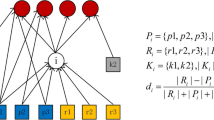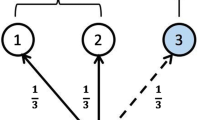Abstract
Taking advantage of the easy access to the rich and massive scholarly data, more and more researchers are focusing on the studies of analyzing and utilizing the scholarly big data. Among them, evaluating the scientific impact of scholars has significant importance. Measuring the scientific impact of scholars can not only provide basis for the applications of academic foundations and awards, but also shed light on the research directions for scholars. Currently, citation based methods and network based metrics are the most commonly used ways to evaluate the scientific impact. However, these approaches ignore several important facts, i.e. the dynamics of citations and the initial qualities of different articles. To alleviate the shortcomings of them, we propose a Time-aware Ranking algorithm (TRank) to evaluate the impact of scholars. Due to scholars’ sustainable supreme concerns of academic innovations, the TRank algorithm gives more credits to the newly published scholarly papers as well as their references according to the representative time functions. Our method also combines the merits of random walk algorithms and heterogeneous network topology, i.e. the mutual influences among different scholarly entities in heterogeneous academic networks. To validate the suitable time function for TRank algorithm and explore its performance, we construct the experiments on two real datasets: (1) Digitial Bibliography and Library Project, and (2) American Physical Society. The experimental results demonstrate that our algorithm outperforms other methods in selecting outstanding scholars and the evaluation results on the overall impact of scholars.









Similar content being viewed by others
References
Abbasi, A. (2013). h-type hybrid centrality measures for weighted networks. Scientometrics, 96(2), 633–640.
Amjad, T., Daud, A., Che, D., & Akram, A. (2016). Muice: Mutual influence and citation exclusivity author rank. Information Processing and Management, 52(3), 374–386.
Amjad, T., Ding, Y., Daud, A., Xu, J., & Malic, V. (2015). Topic-based heterogeneous rank. Scientometrics, 104(1), 313–334.
Bai, X., Xia, F., Lee, I., Zhang, J., & Ning, Z. (2016). Identifying anomalous citations for objective evaluation of scholarly article impact. PLoS ONE, 11(9), e0162364.
Bollen, J., Van de Sompel, H., Hagberg, A., & Chute, R. (2009). A principal component analysis of 39 scientific impact measures. PLoS ONE, 4(6), e6022.
Du, Y.-P., Yao, C.-Q., & Li, N. (2015). Using heterogeneous patent network features to rank and discover influential inventors. Frontiers of Information Technology and Electronic Engineering, 16(7), 568–578.
Dunaiski, M., Visser, W., & Geldenhuys, J. (2016). Evaluating paper and author ranking algorithms using impact and contribution awards. Journal of Informetrics, 10(2), 392–407.
Egghe, L. (2006). Theory and practise of the g-index. Scientometrics, 69(1), 131–152.
Fiala, D., Šubelj, L., Žitnik, S., & Bajec, M. (2015). Do pagerank-based author rankings outperform simple citation counts? Journal of Informetrics, 9(2), 334–348.
Hirsch, J. E. (2005). An index to quantify an individual’s scientific research output. Proceedings of the National Academy of Sciences of the United States of America, 102(46), 16569–16572.
Jiang, X., Sun, X., Yang, Z., Zhuge, H., & Yao, J. (2015). Exploiting heterogeneous scientific literature networks to combat ranking bias: Evidence from the computational linguistics area. Journal of the Association for Information Science and Technology, 67(7), 1679–1702.
Ke, W. (2013). A fitness model for scholarly impact analysis. Scientometrics, 94(3), 981–998.
Kleinberg, J. M. (1999). Authoritative sources in a hyperlinked environment. Journal of the ACM, 46(5), 604–632.
Kong, X., Zhou, J., Zhang, J., Wang, W., & Xia, F. (2015). Taprank: A time-aware author ranking method in heterogeneous networks. In Proceedings of the 2015 IEEE international conference on smart city/socialCom/sustainCom (SmartCity) (pp. 242–246). IEEE.
Li, L., Wang, X., Zhang, Q., Lei, P., Ma, M., & Chen, X. (2014). A quick and effective method for ranking authors in academic social network. In Multimedia and ubiquitous engineering (pp. 179–185).
Li, Y., Wu, C., Wang, X., & Luo, P. (2014). A network-based and multi-parameter model for finding influential authors. Journal of Informetrics, 8(3), 791–799.
Liu, J., Li, Y., Ruan, Z., Fu, G., Chen, X., Sadiq, R., et al. (2015). A new method to construct co-author networks. Physica A Statistical Mechanics and its Applications, 419, 29–39.
Liu, Z., Huang, H., Wei, X., & Mao, X. (2014). Tri-rank: An authority ranking framework in heterogeneous academic networks by mutual reinforce. In IEEE international conference on tools with artificial intelligence (ICTAI) (pp. 493–500). IEEE.
Loglisci, C., Ceci, M., & Malerba, D. (2015). Relational mining for discovering changes in evolving networks. Neurocomputing, 150(Part A), 265–288.
Nykl, M., Ježek, K., Fiala, D., & Dostal, M. (2014). Pagerank variants in the evaluation of citation networks. Journal of Informetrics, 8(3), 683–692.
Page, L., Brin, S., Motwani, R., & Winograd, T. (1999). The PageRank citation ranking: Bringing order to the web. London: Stanford InfoLab.
Qiu, J.-P., Dong, K., & Yu, H.-Q. (2014). Comparative study on structure and correlation among author co-occurrence networks in bibliometrics. Scientometrics, 101(2), 1345–1360.
Senanayake, U., Piraveenan, M., & Zomaya, A. (2015). The pagerank-index: Going beyond citation counts in quantifying scientific impact of researchers. PLoS ONE, 10(8), e0134794.
Sun, Y., & Han, J. (2013). Mining heterogeneous information networks: A structural analysis approach. ACM SIGKDD Explorations Newsletter, 14(2), 20–28.
Tang, J., Zhang, J., Yao, L., Li, J., Zhang, L., & Su, Z. (2008). Arnetminer: Extraction and mining of academic social networks. In Proceedings of the 14th ACM SIGKDD international conference on Knowledge discovery and data mining (pp. 990–998). ACM.
Thombs, B. D., Levis, A. W., Razykov, I., Syamchandra, A., Leentjens, A. F., Levenson, J. L., et al. (2015). Potentially coercive self-citation by peer reviewers: A cross-sectional study. Journal of Psychosomatic Research, 78(1), 1–6.
Wan, X., & Liu, F. (2014). Are all literature citations equally important? Automatic citation strength estimation and its applications. Journal of the Association for Information Science and Technology, 65(9), 1929–1938.
Wang, W., Yu, S., Bekele, T. M., Kong, X., & Xia, F. (2017). Scientific collaboration patterns vary with scholars academic ages. Scientometrics, 1–15. doi:10.1007/s11192-017-2388-9.
Wang, Y., Tong, Y., & Zeng, M. (2013). Ranking scientific articles by exploiting citations, authors, journals, and time information. In Twenty-seventh AAAI conference on artificial intelligence (pp. 933–939).
West, J. D., Jensen, M. C., Dandrea, R. J., Gordon, G. J., & Bergstrom, C. T. (2013). Author-level eigenfactor metrics: Evaluating the influence of authors, institutions, and countries within the social science research network community. Journal of the American Society for Information Science and Technology, 64(4), 787–801.
Xia, F., Su, X., Wang, W., Zhang, C., Ning, Z., & Lee, I. (2016). Bibliographic analysis of nature based on twitter and facebook altmetrics data. PLoS ONE, 11(12), e0165997.
Xia, F., Wang, W., Bekele, T. M., & Liu, H. (2017). Big scholarly data: A survey. IEEE Transactions on Big Data, 3(1), 18–35.
Xu, H., Martin, E., & Mahidadia, A. (2014). Contents and time sensitive document ranking of scientific literature. Journal of Informetrics, 8(3), 546–561.
Yan, E., & Ding, Y. (2012). Scholarly network similarities: How bibliographic coupling networks, citation networks, cocitation networks, topical networks, coauthorship networks, and coword networks relate to each other. Journal of the American Society for Information Science and Technology, 63(7), 1313–1326.
Author information
Authors and Affiliations
Corresponding author
Rights and permissions
About this article
Cite this article
Zhang, J., Ning, Z., Bai, X. et al. Exploring time factors in measuring the scientific impact of scholars. Scientometrics 112, 1301–1321 (2017). https://doi.org/10.1007/s11192-017-2458-z
Received:
Published:
Issue Date:
DOI: https://doi.org/10.1007/s11192-017-2458-z




